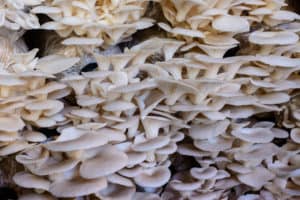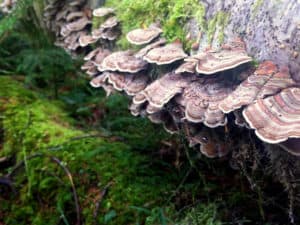It’s true! Mushrooms possess great potential for solving many of the woes of the world. From cleaning up oil spills to providing valuable nutrition to treating cancer, the possibilities are as varied as they are important.
Cleaning Up Toxic Chemicals, Oil Spills, and Decontaminating Water
Using a process called mycoremediation, mushrooms are rising up as a feasible method to clean up toxic pollution. If you’ve ever seen a mushroom growing through plastic, through floorboards, or around cement, you know the powerful potential they possess. It’s not just that they grow through and around all these things, it is what they do in the process.
Mushrooms feed on all sorts of material, using natural enzymes to break substances down and turn them into fungi food. Research shows that mushrooms possess an innate ability to break down hydrocarbons, including those in oil.
The 120 identified enzymes work to decompose the toxins, though it doesn’t stop there. Soil treated with these mushrooms isn’t just cleaned, it is renewed and reinvigorated, able to be used for other purposes.
Past and current projects investigating the effects of fungi in combating pollution:
- A plot of land polluted with diesel fuel, and then inoculated with oyster mushrooms, demonstrated that over a 16-week period, the contamination dropped from 10,000 parts per million to 200 parts per million.
- Treating polluted soil left in the aftermath of the 2017 wildfires that swept through California. Multiple types of pesticides, burnt paint, pressure-treated wood, propane tanks, and other pollutants were left behind, spreading toxins deep into the soil. After all the debris was removed, the polluted ground was covered with special straw-filled tubes inoculated with oyster mushrooms.
- Using oyster mushrooms to clean up accidental fuel spills from boats in a Denmark harbor. A floating tube filled with oyster mushroom mycelium floats in the harbor near the gas station. The mycelium is being tested for its efficacy in saltwater applications.
- Cleaning up oil on the beaches of San Francisco after a tanker spilled 53,000 gallons into the harbor. A two-pronged method was used, utilizing mats of woven human hair to soak up the oil, and then layering it with oyster mushroom mycelium to compost the hazardous waste.
- Utilizing local fungi to fight toxic waste pools in the Amazon. These pits are leftover from oil extraction processes and abandoned by the oil companies that created them.
- Removing PCP, a type of pesticide, from the soil in New Zealand. Bioremediation with white-rot fungus and Oyster mushrooms demonstrated an effective reduction of pesticides.
- Removal of heavy metals from polluted water, with the goal of making the water usable again.
- Recent research shows oyster mushrooms can break down dirty diapers. Considering each baby uses 8,000 diapers before potty-training, this creates considerable bulky waste in landfills.
- Researching methods to use fungi to break down plastic waste. Preliminary trials show significant progress.
A Low-Impact, Nutritious Food Source
Mushroom are delicious, of course, yet there is more to them than just taste. High in nutrients and with many easy-to-cultivate options, mushrooms can revolutionize our food system.

In WWII, Germany cultivated oyster mushrooms for food as a subsistence measure. Rationing was in full effect at the time, and oyster mushrooms could be grown quickly and provided excellent nutrition.
Mushrooms contain between 3.3-2.2 grams of protein per ½ cup serving. Combined with their low calorie and low fat intake per serving, they are on par, and in many ways healthier, than popular meat sources.
Mushrooms also contain significant amounts of niacin, iron, riboflavin, potassium, Vitamin D, and fiber. They are also rich in antioxidants.
Growing mushrooms requires much less resources (land, water, processing) than the majority of meat sources. Oyster mushrooms take as little as 12-14 weeks to harvest from initial inoculation. And, they can go from harvest to table immediately without additional processing, unlike meat sources which require slaughterhouses.
Medicinal Mushrooms
Traditional and Eastern practitioners have advocated the medicinal qualities of mushrooms for centuries. Western researchers recently have also begun to look into them for treating a whole host of diseases, including cancer, high blood pressure and diabetes.
A compound found in shiitake mushrooms, called AHCC, shows effectiveness in fighting liver cancer and liver disease. The AHCC improved overall liver function and demonstrated tumor-fighting abilities. It also potentially can reduce the side-effects of chemotherapy.

Research into the Turkey Tail mushroom indicated it improved the life expectancy of cancer patients, as well as reducing the probability of the cancer returning.
Extracts of Turkey Tail, containing the naturally occurring PSK, which is one of the main active components, is an officially approved cancer treatment in Japan.
The Reishi mushroom is being studied for its immunomodulatory properties. Immune-modulators boost or suppress the immune system as the body needs.
Their use is essential to the health and recovery from many diseases, and specifically cancer. Case studies show it may help to boost the immune system response in gastrointestinal and liver cancers.
Conclusion
The potential benefits of mushrooms are astounding, to say the least. There are over 10,000 species of mushrooms known in the world at this time, and there is likely much more to be discovered, as well.
As a food supply, medicinal source, and pollution fighter, the importance of mushrooms is only just being recognized. There is undoubtedly much more to come.
References:
DICKSON, UDEME & Coffey, Michael & Mortimer, Robert & Di Bonito, Marcello & Ray, Nicholas. (2019). Mycoremediation of Petroleum Contaminated Soils: Progress, Prospects and Perspectives. Environmental Science: Processes & Impacts. 21. 10.1039/C9EM00101H.
Crusberg TC, Mark SS. Biosorption of heavy metals: bacteria, yeast, fungi and plants, in metals: mine drainage, removal and toxicity. In: Britz M, Robbins N, Roddick F, eds. Part of the series, Current Issues in Global Environmental Biotechnology, Wise DL, ed. Elsevier Science 1997.
Christopher J. Rhodes (2014) Mycoremediation (bioremediation with fungi) – growing mushrooms to clean the earth, Chemical Speciation & Bioavailability, 26:3, 196-198, DOI: 10.3184/095422914X14047407349335
Nutrition You Can Use, Do Mushrooms Have Protein, https://nutritionyoucanuse.com/do-mushrooms-have-protein
Six Steps to Growing Mushrooms, Penn State Extension, https://extension.psu.edu/six-steps-to-mushroom-farming
Agricultural Marketing Resource Center, Mushrooms Profile, https://www.agmrc.org/commodities-products/specialty-crops/mushrooms-profile
Memorial Sloan Kettering Cancer Center, AHCC, https://www.mskcc.org/cancer-care/integrative-medicine/herbs/ahcc
Memorial Sloan Kettering Cancer Center, Coriolus Versicolor, https://www.mskcc.org/cancer-care/integrative-medicine/herbs/coriolus-versicolor
Memorial Sloan Kettering Cancer Center, Reishi, https://www.mskcc.org/cancer-care/integrative-medicine/herbs/reishi-mushroom




